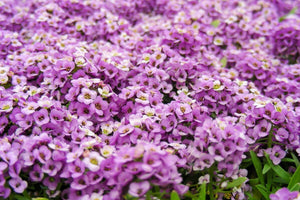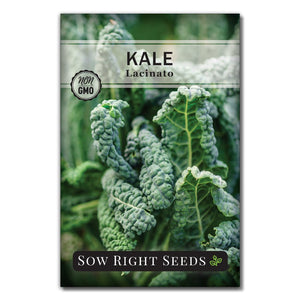How to Plant Watercress from Seed for Indoor and Outdoor Growing
Leafy greensIf you love growing edible plants indoors, watercress is the plant to grow! Wondering what to do with that perpetually damp spot in your garden? Grow watercress. Indoors or out, watercress is an incredibly easy and healthy plant to add to your garden.

If you’re looking for healthy greens that are easy to grow or love foraging but are concerned about possible contaminates, it’s time to start growing watercress at home.
Watercress is a semi-aquatic plant that grows naturally along streams and places of slow-moving fresh water. This is important to keep in mind when considering where to grow watercress. While this can be challenging in some gardens, it’s one reason why watercress is becoming a popular plant for home hydroponic gardens. The other reason for its increasing popularity is the recognition of watercress as one of the healthiest foods density-wise.
There are several varieties of watercress. Our heirloom variety, Nasturtium officinale, is a perennial that can produce dime-sized leaves.
How to Grow Watercress From Seed
Watercress seeds are so tiny, but they have incredible growth potential. You can grow one of the healthiest, nutrient-dense foods from these little specks.

Watercress Seed Starting Tips
Seeds germinate in temperatures around 60 to 70º F.
You can start seeds indoors and then transplant watercress seedlings when temperatures exceed 50ºF.
Plant seeds on moist growing medium. (For hydroponic growing rockwool is a popular choice.)
Watercress seeds can be covered to a depth of 1/4” or just pressed lightly into the soil.
Keep seeds moist until they germinate in 8 to 15 days.
Once the watercress seedlings are several inches high with true leaves, you can transplant them outdoors. Place the seedlings about 8 inches apart.
Watercress can also be propagated once it is growing. The plant will send out little roots searching for more water. Each piece of the plant with these roots can be cut and placed in water to start a new plant. This ability to produce roots all along the vine is how watercress spreads in its natural watery habitat.

Growing Watercress Plants
Watercress plants can be grown indoors or outside. Either way you grow watercress, you will want to make sure that plants always have enough water, sunshine, and nutrients.
Sun
In an ideal situation, watercress plants will have morning sun and afternoon shade. It grows best in full sun which means at least 6 hours a day. The leaves won’t grow as big with less light, but you’ll still have tender greens to eat.
Since watercress prefers cooler temperatures, shade in the afternoon will help protect it from intense heat.
When growing watercress indoors, use a grow light to ensure the plant gets enough light for healthy growth.
Soil
Although watercress is often grown hydroponically, it can also be grown in soil. It does best with nutrient-rich soil that can hold moisture.
Water
Water is an essential part of growing watercress. In its natural habitat, you’ll find watercress growing along streams of fresh water and damp places. Water your plants often enough that the soil always stays moist.
Fertilizer
If growing hydroponically, you will need a hydroponic nutrient solution. Watercress grown in soil will benefit from a high-nitrogen fertilizer.
Temperature
Watercress can be grown as a perennial in locations that don’t get below freezing. It also does best in mild temperatures. When temperatures rise above 85ºF, it can affect the flavor. (Source: USU Extension)

Quick Tips for Growing Watercress Indoors
There are many ways to grow watercress indoors. This is the simplest way that we use. We call it the 2-Pot Method.
One pot holds the soil and has lots of drainage holes. The second pot holds all the extra water and doesn’t have any drainage.
Fill the first pot with potting soil and plant the seeds as detailed. Place the pot of seeds inside another pot with some rocks on the bottom to keep the inner pot suspended a little bit. As you water the watercress, this second pot will collect all the extra water and ensure the plant never dries out.
Aerate the water every other day or up to 3 days. Aerating adds oxygen to the water and helps prevent the water at the bottom from becoming too stagnant. You can do this by lifting and lowering the inner pot a few times. You will also need to dump out the water periodically and put in new water.
Watercress can spread through little shoots of roots. Cut it back or thin to keep the plant contained.
Pests & Diseases
Watercress growing outside may need to be protected from rabbits and snails. Indoors, you’ll want to make sure you refresh your water often to prevent algae growth.

Harvesting Watercress
Harvest watercress before it starts blooming, as this changes the flavor.
Cut off the watercress leaves with some of the stems. Leave a few inches, and the rest of the plant will keep growing.
Thin watercress stems are less fibrous and better for eating. You can eat watercress raw as a topping or as the main ingredient in watercress salad. It adds a fresh, peppery taste.
Watercress Nutrition
In addition to being easy to grow, watercress is also ranked as the healthiest food by the CDC. (Source: CDC Food Table)
This little green plant provides a good amount of essential vitamins and minerals. According to the USDA, 100 grams of watercress has 120 mg of calcium, 21 mg of magnesium, 60 mg of phosphorus, 330 mg of potassium (vitamin K), and 43 mg of vitamin C, along with many other nutrients.
If you love easy-to-grow, healthy greens, you’ll want to add watercress to your indoor or outdoor garden. And for all you foragers out there, growing your own watercress will ensure you have a fresh supply without the danger of pesticides and other contaminants.
This nutrient-dense powerhouse is just what you’re looking for. Make your own watercress salad or add it to smoothies. It’s a beautiful and healthy garnish that will improve any dish.








Barbara – Thanks for the question. Our seeds are packaged by weight. Our packets hold 500mg, which is about 2700 watercress seeds.
how many seeds in watercress packet
Leave a comment